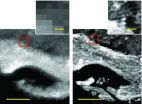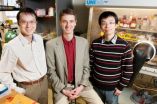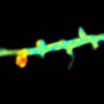(Press-News.org) With intensity a million times brighter than sunlight, a new synchrotron-based imaging technique offers high-resolution pictures of the molecular composition of tissues with unprecedented speed and quality. Carol Hirschmugl, a physicist at the University of Wisconsin-Milwaukee (UWM), led a team of researchers from UWM, the University of Illinois at Urbana-Champaign and University of Illinois at Chicago (UIC) to demonstrate these new capabilities.
Hirschmugl and UWM scientist Michael Nasse have built a facility called "Infrared Environmental Imaging (IRENI)," to perform the technique at the Synchrotron Radiation Center (SRC) at UW-Madison. The new technique employs multiple beams of synchrotron light to illuminate a state-of-the-art camera, instead of just one beam.
IRENI cuts the amount of time needed to image a sample from hours to minutes, while quadrupling the range of the sample size and producing high-resolution images of samples that do not have to be tagged or stained as they would for imaging with an optical microscope.
"Since IRENI reveals the molecular composition of a tissue sample, you can choose to look at the distribution of functional groups, such as proteins, carbohydrates and lipids," says Hirschmugl, "so you concurrently get detailed structure and chemistry."
The technique could have broad applications not only in medicine, but also in pharmaceutical drug analysis, art conservation, forensics, biofuel production, and advanced materials, such as graphene, she says.
Funded by $1 million grant from the National Science Foundation's Major Research Instrumentation Program, the development of the facility has quickly attracted other projects supported by the NSF and the National Institutes of Health. It is published online today in Nature Methods.
The work is a collaboration with the labs of Rohit Bhargava, assistant professor of bioengineering at the University of Illinois at Urbana-Champaign and pathologists Dr. Virgilia Macias and Dr. André Kajdacsy-Balla at UIC. "It has taken three years to establish IRENI as a national user facility located at the SRC," says Nasse. "It is the only facility of its kind worldwide."
Chemical fingerprints
The unique features of the synchrotron make it a highly versatile light source in spectroscopy. Streams of speeding electrons emit continuous light across the entire electromagnetic spectrum so that researchers can access whatever wavelength is best absorbed for a particular purpose.
Although not visible to the human eye, the mid-infrared range of light used by the team documents the light absorbed at thousands of locations on the sample, forming graphic "fingerprints" of biochemically important molecules.
Using 12 beams of synchrotron light in this range allows researchers to collect thousands of these chemical fingerprints simultaneously, producing an image that is 100 times less-pixelated than in conventional infrared imaging.
"We did not realize until now the improvement in detail and quality that sampling at this pixel size would bring," says Bhargava. "The quality of the chemical images is now quite similar to that of optical microscopy and the approach presents exciting new possibilities."
Testing for future applications
The team tested the technique on breast and prostate tissue samples to determine its capabilities for potential use in diagnostics for cancer and other diseases. The researchers were able to detect features that distinguished the epithelial cells, in which cancers begin, from the stromal cells, which are the type found in deeper tissues, with unprecedented detail.
Separating the two layers of cells is a "basement membrane" which prevents malignant cells from spreading from the epithelial cells into the stromal cells. Early-stage cancers are concentrated in the epithelial cells, but metastasis occurs when the basement membrane is breached. Using a prostate cancer sample, the team had encouraging results in locating spectra of the basement membrane, but more work needs to be done.
"IRENI provides us a new opportunity to study tissues and provides lessons for the development of the next generation of IR imaging instruments," says Michael Walsh, a Carle Foundation Hospital-Beckman Institute post-doctoral fellow at the University of Illinois at Urbana-Champaign and co-author on the paper.
It opens the door for development of synchrotron-based imaging that can monitor cellular processes, from simple metabolism to stem cell specialization.
INFORMATION:
New imaging technique provides rapid, high-definition chemistry
Chemical images now much more detailed
2011-03-21
ELSE PRESS RELEASES FROM THIS DATE:
Ethnic minorities are 'silent sufferers' of chronic fatigue syndrome
2011-03-21
Chronic fatigue syndrome (CFS) is characterized by unexplained and debilitating tiredness and is associated with headaches, disrupted sleep, muscle pain and difficulty in concentrating. New research published by BioMed Central's open access journal BMC Medicine shows that ethnicity, depression, lack of exercise or social support, and social difficulties are major risk factors for CFS.
A multi-institute study funded by the Medical Research Council (UK), involving researchers across London and Manchester, looked at data from over 4000 adults living in England. The result ...
Climate change hits home
2011-03-21
Direct experience of extreme weather events increases concern about climate change and willingness to engage in energy-saving behaviour, according to a new research paper published in the first edition of the journal Nature Climate Change this week.
In particular, members of the British public are more prepared to take personal action and reduce their energy use when they perceive their local area has a greater vulnerability to flooding, according to the research by Cardiff and Nottingham universities.
Although no single flooding event can be attributed to climate change, ...
PMH researchers create an organic nanoparticle that uses sound and heat to find and treat tumors
2011-03-21
A team of scientists from Princess Margaret Hospital have created an organic nanoparticle that is completely non-toxic, biodegradable and nimble in the way it uses light and heat to treat cancer and deliver drugs. (A nanoparticle is a minute molecule with novel properties).
The findings, published online today in Nature Materials (DOI: 10.1038/NMAT2986) are significant because unlike other nanoparticles, the new nanoparticle has a unique and versatile structure that could potentially change the way tumors are treated, says principal investigator Dr. Gang Zheng, Senior ...
Batteries charge quickly and retain capacity, thanks to new structure
2011-03-21
CHAMPAIGN, Ill. — The batteries in Illinois professor Paul Braun's lab look like any others, but they pack a surprise inside.
Braun's group developed a three-dimensional nanostructure for battery cathodes that allows for dramatically faster charging and discharging without sacrificing energy storage capacity. The researchers' findings will be published in the March 20 advance online edition of the journal Nature Nanotechnology.
Aside from quick-charge consumer electronics, batteries that can store a lot of energy, release it fast and recharge quickly are desirable for ...
Scientists discover major clue in long-term memory making
2011-03-21
DURHAM, N.C. – You may remember the color of your loved one's eyes for years. But how?
Scientists believe that long-term potentiation (LTP) – the long-lasting increase of signals across a connection between brain cells -- underlies our ability to remember over time and to learn, but how that happens is a central question in neuroscience.
Researchers at Duke University Medical Center have found a cascade of signaling molecules that allows a usually very brief signal to last for tens of minutes, providing the brain framework for stronger connections (synapses) that can ...
The Nuts and Bolts of the Social Security Disability Appeals Process
2011-03-21
Social Security disability benefits provide an important safety net for thousands of Americans: studies cited by the Social Security Administration show that a 20-year-old worker has a 3-in-10 chance of becoming disabled at some point before reaching retirement. The benefits furnished through Social Security help disabled workers and their families maintain normal, productive lives. But what about those workers whose disability claims are denied by the SSA? Fortunately, a process is set forth that allows disabled workers to seek review of claims that may have been wrongly ...
Think globally, but act locally when studying plants, animals, global warming, researchers advise
2011-03-21
Contact: Camille Parmesan
parmesan@uts.cc.utexas.edu
512-232-1860
Michael C. Singer
sing@mail.utexas.edu
512-471-4506
University of Texas at Austin
Think globally, but act locally when studying plants, animals, global warming, researchers advise
AUSTIN, Texas—Global warming is clearly affecting plants and animals, but we should not try to tease apart the specific contribution of greenhouse gas driven climate change to extinctions or declines of species at local scales, biologists from The University of Texas at Austin advise.
Camille Parmesan, Michael ...
A Wrong Way Crash And A Wrongful Death
2011-03-21
A woman died because of a fatal accident, and her family has sued a Lynwood village clerk for negligence after the crash, the Chicago Sun Times reported.
Rolle Valle, driving the wrong way on Illinois Route 394 near East Lincoln Highway, crashed head-on into two cars.
Valle, the clerk in the village of Lynwood, has been charged with reckless homicide and aggravated DUI in connection with the fatal accident.
State Police said Valle was driving northbound in the southbound lane. His vehicle struck the other car head-on and the impact caused the car to roll over in ...
Metabolite levels may be able to improve diabetes risk prediction
2011-03-21
Measuring the levels of small molecules in the blood may be able to identify individuals at elevated risk of developing type 2 diabetes as much as a decade before symptoms of the disorder appear. In a report receiving advance online release in Nature Medicine, a team led by Massachusetts General Hospital (MGH) researchers describes finding that levels of five amino acids not only indicated increased diabetes risk in a general population but also could differentiate, among individuals with traditional risk factors such as obesity, those most likely to actually develop diabetes. ...
New data published in Nature Genetics demonstrate that tiny LNA-based compounds developed by Santaris Pharma A/S inhibit entire disease-associated microRNA families
2011-03-21
Tiny Locked Nucleic Acid (LNA) based compounds, which are 8-mer LNA oligonucleotides, successfully inhibit entire microRNA families, providing potential new approach for treating a variety of diseases, including cancer, viral infections, cardiovascular and muscle diseases
Data show high affinity and target specificity of tiny LNA-based compounds enabled functional inhibition of entire microRNA families in a range of tissues without off-target effects
Tiny LNA-based compounds are well tolerated in preclinical studies and can be delivered without the use of complex ...
LAST 30 PRESS RELEASES:
First Editorial of 2026: Resisting AI slop
Joint ground- and space-based observations reveal Saturn-mass rogue planet
Inheritable genetic variant offers protection against blood cancer risk and progression
Pigs settled Pacific islands alongside early human voyagers
A Coral reef’s daily pulse reshapes microbes in surrounding waters
EAST Tokamak experiments exceed plasma density limit, offering new approach to fusion ignition
Groundbreaking discovery reveals Africa’s oldest cremation pyre and complex ritual practices
First breathing ‘lung-on-chip’ developed using genetically identical cells
How people moved pigs across the Pacific
Interaction of climate change and human activity and its impact on plant diversity in Qinghai-Tibet plateau
From addressing uncertainty to national strategy: an interpretation of Professor Lim Siong Guan’s views
Clinical trials on AI language model use in digestive healthcare
Scientists improve robotic visual–inertial trajectory localization accuracy using cross-modal interaction and selection techniques
Correlation between cancer cachexia and immune-related adverse events in HCC
Human adipose tissue: a new source for functional organoids
Metro lines double as freight highways during off-peak hours, Beijing study shows
Biomedical functions and applications of nanomaterials in tumor diagnosis and treatment: perspectives from ophthalmic oncology
3D imaging unveils how passivation improves perovskite solar cell performance
Enriching framework Al sites in 8-membered rings of Cu-SSZ-39 zeolite to enhance low-temperature ammonia selective catalytic reduction performance
AI-powered RNA drug development: a new frontier in therapeutics
Decoupling the HOR enhancement on PtRu: Dynamically matching interfacial water to reaction coordinates
Sulfur isn’t poisonous when it synergistically acts with phosphine in olefins hydroformylation
URI researchers uncover molecular mechanisms behind speciation in corals
Chitin based carbon aerogel offers a cleaner way to store thermal energy
Tracing hidden sources of nitrate pollution in rapidly changing rural urban landscapes
Viruses on plastic pollution may quietly accelerate the spread of antibiotic resistance
Three UH Rainbow Babies & Children’s faculty elected to prestigious American Pediatric Society
Tunnel resilience models unveiled to aid post-earthquake recovery
Satellite communication systems: the future of 5G/6G connectivity
Space computing power networks: a new frontier for satellite technologies
[Press-News.org] New imaging technique provides rapid, high-definition chemistryChemical images now much more detailed



